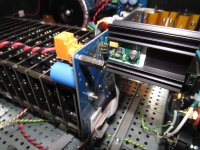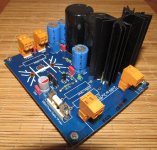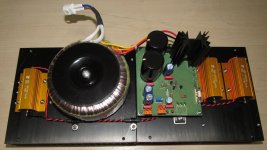Here you see the two 5v regs. That’s all you have to change. Forget about the rest.
I have been trying different 5v regulators on the mainboard. The benchmark is the LF50ABV as supplied as standard.
After a week or two to settle down they are very good performers, with good 3D and resolution of the ambient space.
I tried a Belleson SPM 78 regulator which never seemed to warm up and give much of a 3D presentation.
Then a Micrel MIC29501-5.0BT was tried, which started out OK with a fairly good stereo image but did not have the depth allowed by the LF50.
So after Smooth Dancer had some good results with the LT3045 5v replacements, I thought I would give them a try.
A quick desolder of the LF50 and re install the LT3045-7805 regulator and fit a light duty heatsink to it and have a quick listen.
I only had it going for a quick test to make sure everything was going to be OK and no overheating anywhere.
So I was very pleased to notice that the Dac sounded as good as when I was using a well run in LF50 regulator.
Superb 3D sound with depth aplenty, and no hint of harshness when Dacs are first switched on.
I will leave it alone and powered up for a few days, then have a good listening session later this week.
I will let you know how it goes.
Attachments
Nice Alex. The first a noticed after installing 3045 was that the bass sounded more tight with good definition. For me,and in my setup, the 3045 is worth every penny.
Just now I’m struggle to decide if I shall order the fifo II kit from Ian. I am so happy with the sound as it is, but you know how it is....maybe it’s possible to squeeze more out of our beloved dddac than we already have done ?
If I order from Ian, I will go all in with fifo II, isolator board and dual clock board with som high quality clocks. Anyone who have tried or heard Ian’s fifo with dddac? I use waveio,and have discovered how different my two waveio boards sound. My old waveio have NDK sd clocks and my new waveio have the sda clocks from NDK.
To my surprice I like the old sd clocks better than the new sda. The new sda clocks have more punch and dynamic, but loose when it comes down to the most important for me, and that is flow and coherence. The new sda clocks sound more mecanical or unnatural.
What i discovered regarding the new and old clocks got me curious and I started searching for info why this was the case. The answer is simple. In a batch of, lets say 1000, only 100 or so will measure very good with small tolerances between them, and the rest is bob bob..
I remember reading in the waveio tread that there was a guy who had two waveio card with the new sda clocks from NDK, and the sound was night and day between them. I think he ended up sending one back to Lucien.
If I order the fifo from Ian it seems like it is a must to get new clocks which measure as good as possible and is matched against each other. Probably not easy since not many sellers have the right(and very expensive) equipment to do this.
Just now I’m struggle to decide if I shall order the fifo II kit from Ian. I am so happy with the sound as it is, but you know how it is....maybe it’s possible to squeeze more out of our beloved dddac than we already have done ?
If I order from Ian, I will go all in with fifo II, isolator board and dual clock board with som high quality clocks. Anyone who have tried or heard Ian’s fifo with dddac? I use waveio,and have discovered how different my two waveio boards sound. My old waveio have NDK sd clocks and my new waveio have the sda clocks from NDK.
To my surprice I like the old sd clocks better than the new sda. The new sda clocks have more punch and dynamic, but loose when it comes down to the most important for me, and that is flow and coherence. The new sda clocks sound more mecanical or unnatural.
What i discovered regarding the new and old clocks got me curious and I started searching for info why this was the case. The answer is simple. In a batch of, lets say 1000, only 100 or so will measure very good with small tolerances between them, and the rest is bob bob..
I remember reading in the waveio tread that there was a guy who had two waveio card with the new sda clocks from NDK, and the sound was night and day between them. I think he ended up sending one back to Lucien.
If I order the fifo from Ian it seems like it is a must to get new clocks which measure as good as possible and is matched against each other. Probably not easy since not many sellers have the right(and very expensive) equipment to do this.
Well, waveio stays. Maybe your waveio had clocks with bad specs ? Aurender is my preferred front end and will not be replaced. It’s so user friendly and everything goes smooth without any problems at all.
Is there really no one with dddac and Ians fifo ? Several hundreds have been sold....
Is there really no one with dddac and Ians fifo ? Several hundreds have been sold....
Last edited:
I have been trying different 5v regulators on the mainboard. The benchmark is the LF50ABV as supplied as standard.
After a week or two to settle down they are very good performers, with good 3D and resolution of the ambient space.
I tried a Belleson SPM 78 regulator which never seemed to warm up and give much of a 3D presentation.
Then a Micrel MIC29501-5.0BT was tried, which started out OK with a fairly good stereo image but did not have the depth allowed by the LF50.
So after Smooth Dancer had some good results with the LT3045 5v replacements, I thought I would give them a try.
A quick desolder of the LF50 and re install the LT3045-7805 regulator and fit a light duty heatsink to it and have a quick listen.
I only had it going for a quick test to make sure everything was going to be OK and no overheating anywhere.
So I was very pleased to notice that the Dac sounded as good as when I was using a well run in LF50 regulator.
Superb 3D sound with depth aplenty, and no hint of harshness when Dacs are first switched on.
I will leave it alone and powered up for a few days, then have a good listening session later this week.
I will let you know how it goes.
Thank´s for the info Alex.
I´ve ordered the regulator and are waiting for them to ship.
Is it necessary with the heatsink?
Max 4 of the new boardsLooking at Almeg69s photo above an old question came back to the surface of my brain. What is the maximum number of DAC boards one can run from the standard DDDAC power supply? I have the new/blue mainboard, if this makes a difference.
Thank´s for the info Alex.
I´ve ordered the regulator and are waiting for them to ship.
Is it necessary with the heatsink?
No heatsink Nightpuma. I measured the temp just to be sure. ( don’t remember exactly, but no prob )
Thank’s SmoothieNo heatsink Nightpuma. I measured the temp just to be sure. ( don’t remember exactly, but no prob )
Max 4 of the new boards
Oh no... don't tell me I am already maxed out!
Nice Alex. The first a noticed after installing 3045 was that the bass sounded more tight with good definition. For me,and in my setup, the 3045 is worth every penny.
Just now I’m struggle to decide if I shall order the fifo II kit from Ian. I am so happy with the sound as it is, but you know how it is....maybe it’s possible to squeeze more out of our beloved dddac than we already have done ?
If I order from Ian, I will go all in with fifo II, isolator board and dual clock board with som high quality clocks. Anyone who have tried or heard Ian’s fifo with dddac? I use waveio,and have discovered how different my two waveio boards sound. My old waveio have NDK sd clocks and my new waveio have the sda clocks from NDK.
To my surprice I like the old sd clocks better than the new sda. The new sda clocks have more punch and dynamic, but loose when it comes down to the most important for me, and that is flow and coherence. The new sda clocks sound more mecanical or unnatural.
What i discovered regarding the new and old clocks got me curious and I started searching for info why this was the case. The answer is simple. In a batch of, lets say 1000, only 100 or so will measure very good with small tolerances between them, and the rest is bob bob..
I remember reading in the waveio tread that there was a guy who had two waveio card with the new sda clocks from NDK, and the sound was night and day between them. I think he ended up sending one back to Lucien.
If I order the fifo from Ian it seems like it is a must to get new clocks which measure as good as possible and is matched against each other. Probably not easy since not many sellers have the right(and very expensive) equipment to do this.
I think you are referring to me...
Initially, I sent one WevaIO card for SD -> SDA upgrade. This worked really well, major improvements in definition and most importantly, in faithfulness to how the musical instruments should sound.
Soon to follow was a second WaveIO clock upgrade, same thing, but different end-result. I was disappointed. However, the second WaveIO card had not been used before... ever, i.e. it was a brand new (spare) card. In addition, the first WaveIO card received the firmware upgrade to the very latest version, but the second did not. This firmware is available only from the guy who used to make these boards; it is beyond me why he upgraded the firmware on the first board but missed it (forgot?) on the second.
In my opinion, even the second WaveIO board sounded a bit better with SDA's, so it was a worthwhile upgrade.
I use 2X3045 in parallel for the WaveIO main 5V supply. This combo is set for 5.2V output (gives me almost spot-on 5V after that huge WaveIO series protection diode). This was a significant improvement, compared to a single 3045. In addition, the isolator chip is also supplied by its own 3045.
Thx Boky
But is there no one with Ian’s fifo stuff connected to a dddac in here ?
I had one and reported in this thread. Overall I was a bit disappointed with the SQ and I put this down to the crystal oscillators being mounted on longish legs in a socket-not a good idea when we've got megahz digital flying around. I preferred the sound of the Allo Kali, with its smd mounted oscillators and sold my Ian's version. The Kali is cheaper and works very well, tho is fussy about earthing arrangements and cable layout
David
Thank´s for the info Alex.
I´ve ordered the regulator and are waiting for them to ship.
Is it necessary with the heatsink?
The heatsink is not necessary, but I keep the Dac powered up 24/7 and like to keep everything as cool as possible.
The heatsink is not necessary, but I keep the Dac powered up 24/7 and like to keep everything as cool as possible.
OK. Thanks
Oh no... don't tell me I am already maxed out!
If you remove the TIP122 and replace it on the back of the PCB, you will be able to bolt it to a big heatsink.
Or if you want to go large make some PCB`s that will take the TIP142 transistor.
Attachments
If you remove the TIP122 and replace it on the back of the PCB, you will be able to bolt it to a big heatsink.
Or if you want to go large make some PCB`s that will take the TIP142 transistor.
Alright. More DAC boards = more current = more heat dissipaton from the TIP.
What is a realistic limit for the number of DAC boards (given the TIP is fine)?
I just looked at the DDDAC1794S docs again (on Doedes website: http://dddac.com/documents/dddac1794pbt_nos_ver51.pdf). This says that Tent DAC boards consume 100 mA each. The doc also seems to imply that 8 DAC boards are fine with the stock kit. What am I missing?
- Home
- Source & Line
- Digital Line Level
- A NOS 192/24 DAC with the PCM1794 (and WaveIO USB input)


